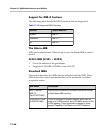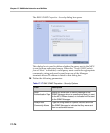
Polycom RMX 2000 Administrator’s Guide
17-69
3 Alarm Fault trap. The third trap type is a family of traps defined in
the POLYCOM-RMX-MIB file, these traps are associated with the
RMX active alarm and clearance (proprietary SNMP trap).
Figure 3 An Example of an Alarm Fault Trap
Each trap is sent with a time stamp, the agent address and the manager
address.
Status Trap Content
The MCU sends status traps for the status MAJOR - a trap is sent when
the card/MCU status is MAJOR.
All trap content is considered “MAJOR”.
rmxFailedConfigUserListInLinuxAlarmFault notification received
from: 172.22.189.154 at 5/20/2007 7:04:22 PM
Time stamp: 0 days 00h:01m:11s.71th
Agent address: 172.22.189.154 Port: 32777 Transport: IP/UDP
Protocol: SNMPv2c Notification
Manager address: 172.22.172.34 Port: 162 Transport: IP/UDP
Community: public
Bindings (6)
Binding #1: sysUpTime.0 *** (timeticks) 0 days
00h:01m:11s.71th
Binding #2: snmpTrapOID.0 *** (oid)
rmxFailedConfigUserListInLinuxAlarmFault
Binding #3: rmxAlarmDescription *** (octets) Insufficient
resources
Binding #4: rmxActiveAlarmDateAndTime *** (octets) 2007-6-
19,16:7:15.0,0:0
Binding #5: rmxActiveAlarmIndex *** (gauge32) 2
Binding #6: rmxActiveAlarmListName *** (octets) Active
Alarm Table
* Binding #7: rmxActiveAlarmRmxStatus *** (rmxStatus) major


















